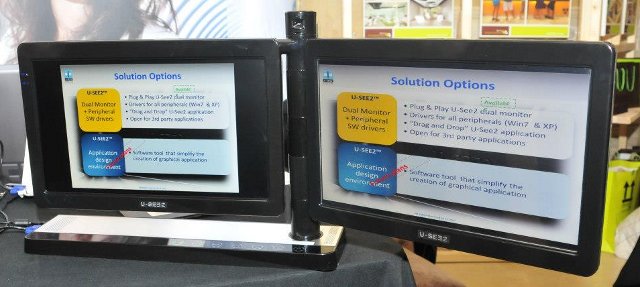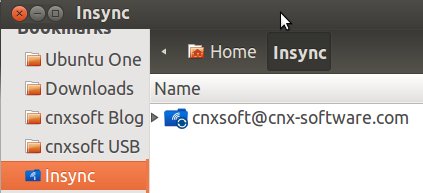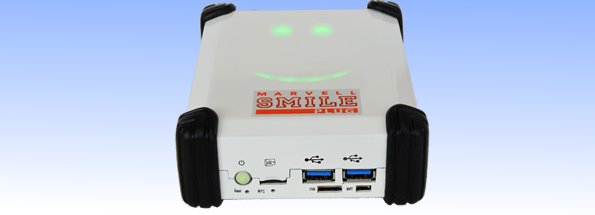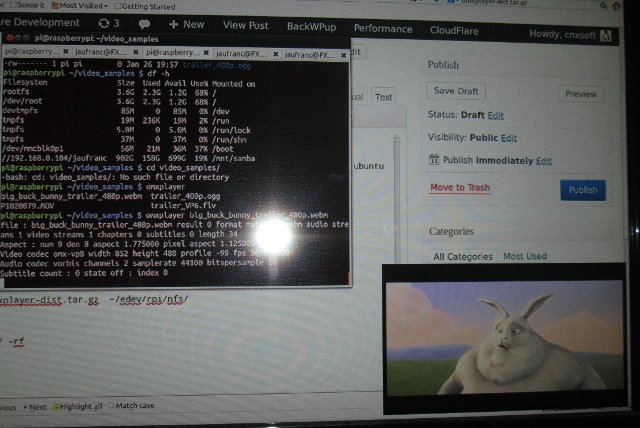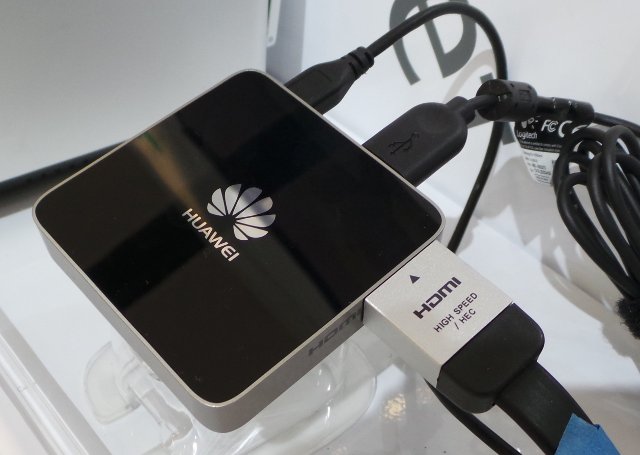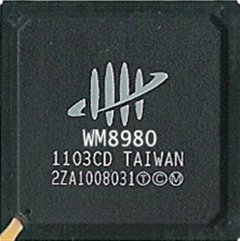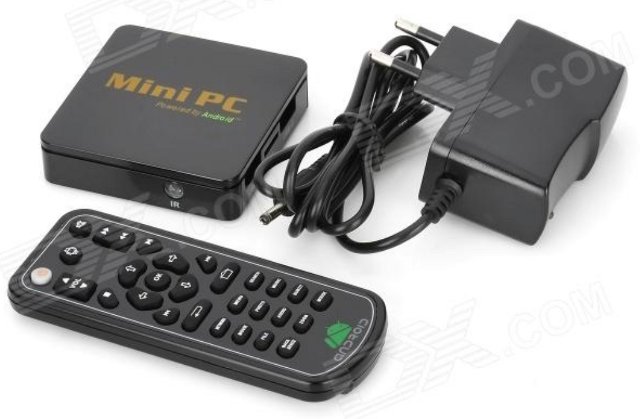WiMe (pronounced “Why Me?”), a Taiwanese company, showcased an Android watch that can also be used as a phone (a Nanophone as the company calls it) at CES 2013. The NanoWatch runs embedded Linux, and features a 1.54″ Touch screen display, 256 Mb ROM, a 4 GB internal microSD card, and a SIM card slot. NanoWatch Specifications: Processor – Unknown System Memory – Unknown Storage – 256 MB ROM, 4 GB internal microSD Display – 1.54″ resistive touch display – Resolution 240×240 Network – GSM/GPRS Quad Band: GSM 850/900/DCS 1800/PCS 1900 MHZ. Data :GPRS SIM/UIM – One standard SIM card Connectivity – Bluetooth 2.1 USB connection – micro 5pin USB, USB 1.1 Video, photo and audio formats – AVI/MP4/3GP, jpg/gif/bmp, and MP3 Battery – 300 mAh Built-in rechargeable lithium-ion battery. Talking time: Approx. 4 hours. Standby time: Approx. 120 hours Misc – FM Radio, Voice recorder Dimensions – 51.6 mm x […]
Display Solution U-See2 Dual-Sided Interactive Display
U-See2 is a dual-sided screen with a swivel arm that allows the system to operate either back-to-back, or in a side-by-side configuration. One of the sides features a touch screen to allow customer’s involvement. This product can be used in consumer or service centers such as travel agencies, banks, point-of-sale retail, doctor’s office, etc… Display Solution, the company behind the project, also explains that it can also be used for education in order to save space (one monitor and one table for 2 students), or at home for dual player gaming. The monitor can be operated in 2 modes: Clone (Mirror) Mode – The image on the primary monitor will duplicate on the second (“client”) monitor. Extended Mode – Extend the view to both monitors over USB and VGA / DVI adapter as configured under Windows. Amazingly the company does not mention screen size (it could be because they provide […]
Google Drive Integration in Ubuntu with Insync
There are several ways to get cloud storage in Ubuntu, and access it from Nautilus with products such as Ubuntu One or Dropbox. But if you’re running out of space with those services, you may also consider using your Google Drive account with Insync (Beta). Here’s how I’ve installed the latest version (0.9.35) in Ubuntu 12.04 64-bit:
|
1 2 3 4 |
wget http://s.insynchq.com/builds/insync-beta-ubuntu_0.9.35_amd64.deb sudo dpkg -i insync-beta-ubuntu_0.9.35_amd64.deb sudo apt-get install xdotool python-nautilus sudo apt-get install -f |
At this point, reboot or restart nautilus (“nautilus -q” in a terminal window). I’ve then used Dash to launch Insynq. This just launched insync website, and allowed me to register my Google Drive account. You should now see Insynq shows up in your home folder. It may be a good idea to add it as a bookmark as well. At this point, you should realize something is not working that well since Insync does not show in the contextual menu. That’s because you need to run insync manually in a terminal window, […]
Marvell SMILE Plug DevKit is Now Available for $199
The SMILE Plug is a development kit, designed jointly by Marvell and Standford University, that brings Wi-Fi connectivity to a classroom, and allows up to 60 pupils / students to interact with their teacher via their phones’ or tablets’ web browser. Other possible applications include cloud computing, wireless AP, industrial control, medical instrumentation, office automation, as well as mesh and grid computing. The SMILE Plug is now available with the following updated specifications: SoC – Marvell ARMv7 compliant Marvell ARMADA 370 CPU System Memory – 512 MB DDR3 Storage – 1 GB NAND Flash + microSD slot Connectivity WiFi 802.11 a/b/g/n via Marvell Avastar 88W8764 4×4 WiFi for up to 60 nodes 2x Gigabit Ethernet USB – 2x USB 3.0 External backup battery for hours of reserve power* (optional accessory) Power on button and restart Power Supply – 12V/2amp external power supply JTAG and UART port for programming and debugging […]
Raspberry Pi Now Has Experimental Support for VP6, VP8, MJPEG and Ogg Theora Video Codecs
The guys working on the Raspberry Pi (mainly dom) have added preliminary support for VP6, VP8, MJPEG, and Ogg Theora free video codecs, as well as Ogg Vorbis audio codec. Unlike H.264, MPEG-2 and VC1, those are not handled by the hardware video decoder in Broadcom BCM2835 processor, but are accelerated by the Videocore GPU. This means that only SD (and possibly 720p) videos are supported for those codecs. The best way to get support is probably to patiently wait for the Raspberry Pi foundation to release a new Raspbian image, but in case you couldn’t possibly wait, here are the steps to follow: Download and run Hexxeh’s rpi-update script in the Raspberry Pi in order to get the very latest build:
|
1 2 3 |
wget https://github.com/Hexxeh/rpi-update/raw/master/rpi-update chmod 755 rpi-update sudo ./rpi-update |
Add the following two lines to /boot/config.txt:
|
1 2 |
start_file=start_x.elf fixup_file=fixup_x.elf |
Reboot the Raspberry Pi The GPU firmware is now updated, but you still need the latest version of omxplayer. […]
Huawei MediaQ M310 Media Player Based on Quad Core K3V2 Processor
I haven’t seen any quad-core set-top boxes on the market (if we exclude some Freescale i.MX6 mini PCs), but this is about to change with Huawei MediaQ M310 media player. The device is based on Hisilicon K3V2 SoC, and comes with 1GB RAM and 4 GB flash. Huawei MediaQ M310 specifications: SoC – HiSilicon K3V2 quad-core Cortex A9 processor with Vivante GC4000 GPU System Memory – 1 GB RAM Storage – 4 GB flash + microSD slot Video I/O – HDMI out and HDMI in Audio I/O – 1x SPDIF, 3.5 mm stereo jack and mic (3-in-1) USB – 2x USB 2.0 host ports Connectivity – Wi-Fi 802.11n & Bluetooth 4.0 Huawei multi-screen (Pushing, mirroring) Content aggregation / Voice Search The box runs a customized version of Android with a user interface designed for the television. CSilie, who tipped me about the MediaQ M310, saw the device at CES 2013, […]
WonderMedia PRIZM WM8980 Dual Cortex A9 SoC
WonderMedia Technologies, a subsidiary of Via Technologies, has recently announced the WonderMedia PRIZM WM8950, a dual core Cortex A9 processor running up to 1.2 Ghz with a Mali-400MP2 GPU. This new SoC supports Android 4.2 Jelly Bean, Linux, and WinCE 7, and targets applications for mobile, digital home and business applications in devices such as tablets, smart TVs, networked projectors, digital signage players, and thin clients. It also features integration of the Wi-Fi CERTIFIED Miracast standard into the WonderMedia SmartStream for support of DMR (Digital Media Renderer) and wireless display functionalities over standard compliant and legacy WiFi direct and WiFi devices in both embedded and Android environments. WM8980 supports HDMI, LVDS, and DVO video interfaces, features a CMOS sensor input for webcams, SD / SDIO / MMC / e-MMC interfaces, USB 2.0 Host/device, audio interfaces (I2S, S/PDIF, PCM), SPI, I2C, UARTs and GPIO. Wi-Fi and Bluetooth can be supported with […]
$59.40 HD18M Android 4.0 Media Player Powered by AMLogic AML8726-M3
Mygica A11 ($65) was the cheapest AMLogic AML8726-M3 Android set-top box I was aware of, but today I’ve come across HD18M with very similar specs (e.g. 1GB RAM, 4GB Flash…) that sells for $59.40 on DealExtreme including shipping. Here are HD18M Android STB Specifications: SoC – AMLogic AML8726-M3 (Cortex A9) processor @ 1.0GHz with Mali-400 GPU System Memory – 1GB DDR3 Storage – 4GB Flash + microSD slot (Up to 32GB) Video Output – HDMI 1.4 (Up to 1080p) Video Formats – AVI, RM, RMVB, TS, VOB, MKV, MOV, WMV, ISO, ASF, FLV, DAT, MPG & MPEG Video Codecs – MPEG1/2/4, H.264, AVC/VC-1, Xvid ,DivX3/4/5/6, and Real Video 8/9/10 Audio Formats – MP3, WMA, WAV, OGG, FLAC, ALAC, APE, TrueHD, AAC, AC3, AC-D, DDP & DTS. Subtitle – srt, smi, ssa and ass USB – 2x USB 2.0 Host ports Connectivity – 10/100 Mbit Ethernet + Wi-Fi 802.11b/g The only […]



